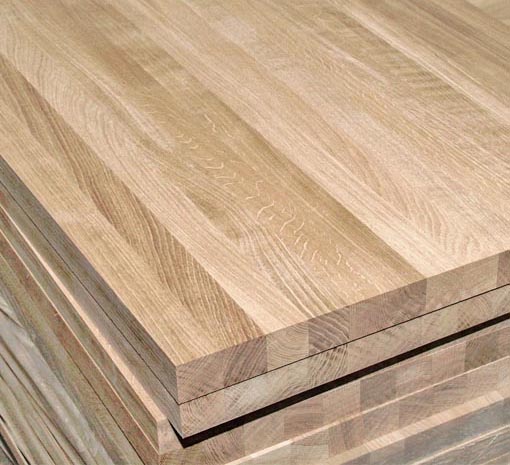At Hashtag Wood, we pride ourselves on our meticulous production process, ensuring the highest standards of precision and quality in every solid oak panel we produce. Our commitment to excellence is reflected in our use of industry-leading Weinig machines, renowned for their high precision and reliability.
From cutting the wood staves to sizing and sanding the panels, each step of our production process is executed with great attention to detail. Our skilled technicians oversee every aspect of production, ensuring that each panel meets our exacting quality standards.
By combining state-of-the-art machinery with meticulous craftsmanship, we deliver solid oak panels of exceptional quality and consistency, trusted by our customers for their durability and elegance.
At Hashtag Wood we are detail-oriented and stick to specific steps to make solid hardwood panels. Our production process consists of the following.
We obtain raw oak logs through auctions held by Romsilva, the Romanian National Forestry Administration responsible for managing and conserving Romania's forestry resources. Romsilva is committed to upholding traceability regulations (FSC) and sustainable exploitation principles.
Our selection process for high-quality hardwood logs involves assessing factors such as colour, grain pattern, and overall quality. Each log undergoes meticulous inspection to identify any flaws, including knots, splits, and insect damage.
Only logs that meet our stringent quality standards are deemed suitable for further processing.
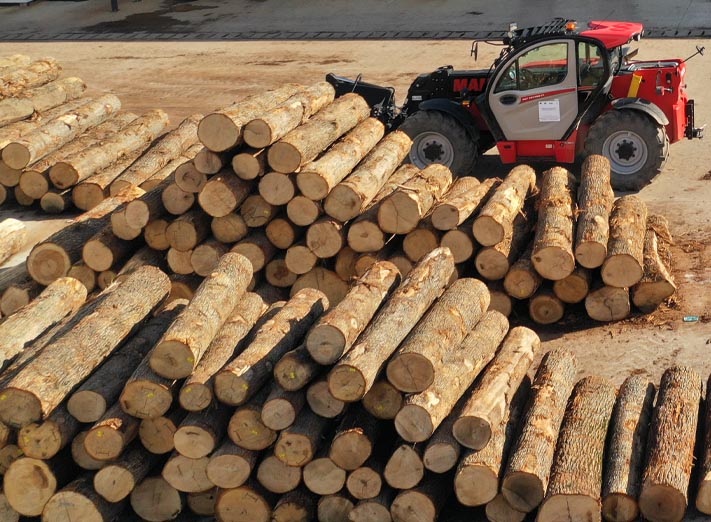
The process begins with cutting oak logs into planks: the logs are securely placed on a conveyor belt that feeds them into the automated laser-guided reducer band saw.
This advanced machinery precisely measures and marks the optimal cutting points on the logs using laser guidance. Once marked, the band saw swiftly and accurately cuts through the logs, producing uniform planks of desired thickness.
These planks are then carefully stacked and transported to the kiln dryer for the necessary drying process, ensuring they are seasoned and ready for use in various applications. This automated process not only streamlines production but also guarantees consistent quality and efficiency.
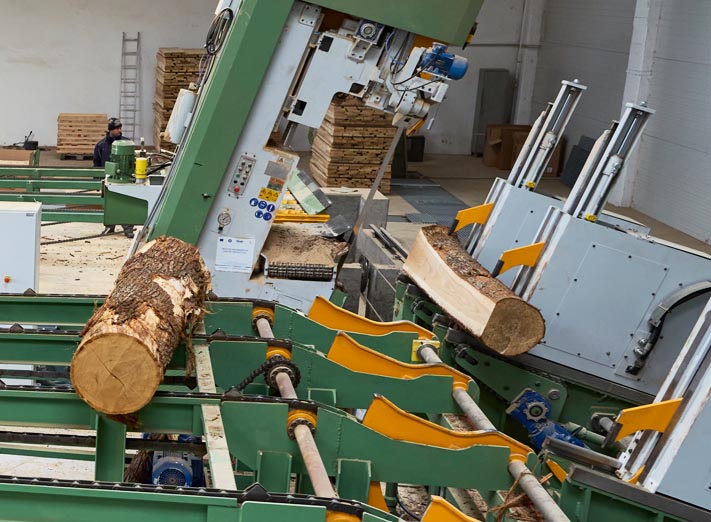
This process is of paramount importance and ensures that the wood reaches the optimal moisture content for stability and durability. We use automated kiln dryers that regulate temperature and humidity levels precisely, allowing for a controlled drying environment. We aim to obtain an 8% humidity level every time.
Wood planks are carefully stacked inside the kiln dryer, where hot air circulates evenly around them, accelerating the drying process without compromising the integrity of the wood.
This automated method not only saves time but also guarantees consistent results, producing high-quality oak panels that are less prone to warping, cracking, or other forms of damage.
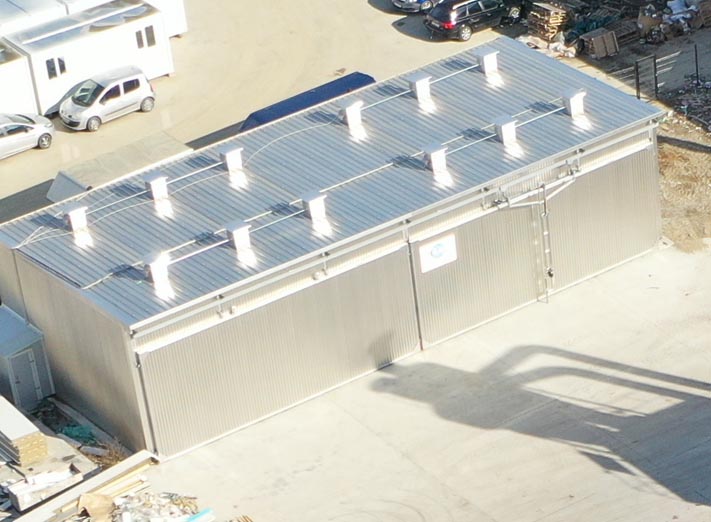
In the production of solid oak panels, the step of cutting the boards into staves of equal width and depth is crucial for ensuring uniformity and quality. We accomplish this process using the high-precision Weinig Variorip 310 multi-blade rip saw.
This advanced machinery allows multiple wood boards to be precisely cut into several equally-sized lamellae or staves simultaneously. The rip saw ensures accuracy and consistency for a perfect cut quality, resulting in planks that are uniform in shape and size.
This precision cutting not only enhances the aesthetics of the final panels but also improves their structural integrity, making them ideally suited for their intended purposes.
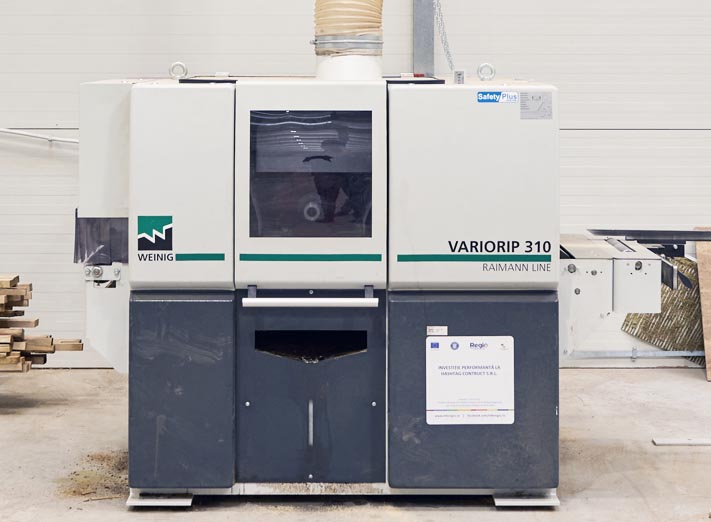
Next, the step of removing knots, marks, and other defects from wood staves is essential to ensure the quality and appearance of the final product. This process is carried out using the Weinig OptiCut 260 optimizing cross-cut saw.
This advanced machinery is specifically designed to identify and cut out imperfections in the wood staves with precision and efficiency.
By carefully scanning each stave, the OptiCut 260 accurately determines the optimal cutting points to remove defects while maximising the usable portions of the wood. This results in high-quality staves that are free from flaws, enhancing the overall aesthetics and durability of the solid oak panels.

In the production of solid oak panels, the step of planing the wood staves is crucial for achieving a smooth and uniform surface. This process is carried out using two high-precision and high-performance machines, the Weinig Profimat 50 and Powermat 700.
These advanced planing machines are designed to precisely trim and smoothen the surfaces of the wood staves to the desired thickness and finish. We ensure consistent results by efficiently removing any unevenness or imperfections from the staves, resulting in a flawless surface that is ready for further processing.
This precision planing not only enhances the aesthetic appeal of the solid oak panels but also improves their structural integrity and durability.

The step of finger jointing the shorter staves is crucial for creating longer and more stable pieces of wood. This process is facilitated by the Weinig Profijoint machine, specifically designed for finger jointing solid hardwood panels.
The Profijoint machine can handle wood of various sizes, including widths up to 150 (170) mm, wood thicknesses up to 50 (80) mm, and wood entry lengths between 150 and 700 mm. It is capable of cutting multiple types of vertical and horizontal finger joint profiles with maximum precision and stability.
The machine applies adhesive to the profiles and bonds them together under pressure and heat, resulting in strong and seamless joints. This finger jointing process ensures that shorter staves are efficiently utilised to create longer and more uniform panels, with minimal waste of wood.
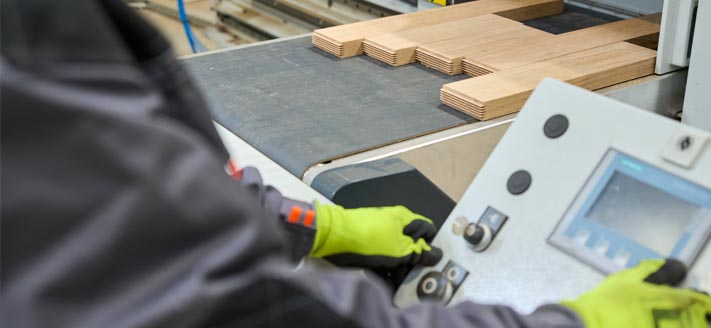
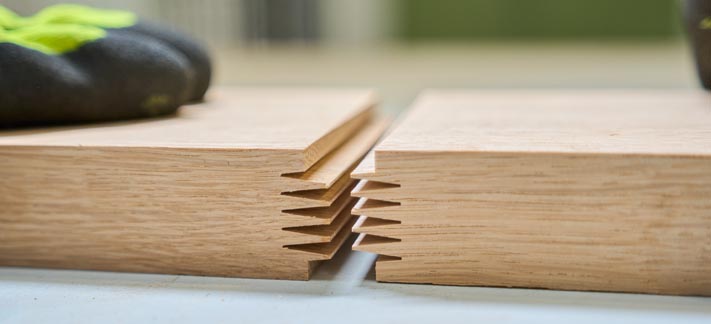
The step of edge-gluing staves into panels is efficiently executed using the Weinig Profipress L II 2500. This advanced machine streamlines the process by automatically applying adhesive to one side of each stave and feeding them onto the main platform.
Here, a technician arranges the staves, pushing each one against the previous ones to form a solid panel assembly. The machine then moves the assembly forward, pressing the staves from all sides and applying pressure both vertically and horizontally.
With the capability to handle single-layer and multi-layer solid wood panels, the Profipress L II 2500 utilises high radio frequency to rapidly heat the glue lines, accelerating the curing process to mere minutes.
Importantly, the high-frequency heating only affects the glue lines, ensuring minimal impact on the wood. This precise and efficient gluing process minimises waste while producing high-quality, durable solid oak panels.


The final step before quality control involves trimming, sizing, and sanding the panels to achieve a smooth and uniform finish. This process ensures that the panels meet the desired dimensions and surface quality standards.
Using precision machinery such as saws and sanders, the panels are trimmed to remove any excess material and sized according to specific requirements. Subsequently, the surfaces of the panels are carefully sanded to eliminate any roughness or imperfections, resulting in a refined and polished appearance.
This meticulous attention to detail in trimming, sizing, and sanding enhances the overall quality and aesthetics of the solid oak panels, preparing them for rigorous quality control checks before they are ready for distribution or further processing.
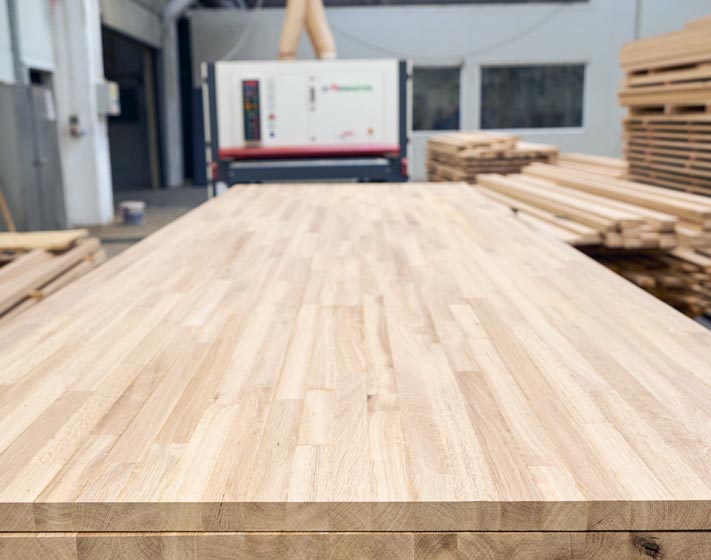
The final step involves conducting a comprehensive quality check on the finished panels. This crucial process ensures that the panels meet the specified standards for dimensions, surface finish, and overall quality.
Our technicians meticulously inspect each panel for any defects, such as knots, cracks, or unevenness, and verify that they adhere to the desired specifications. Additionally, the panels are checked for proper sizing and alignment to ensure consistency across the batch.
Any panels that do not meet the required quality standards are identified and set aside for further evaluation or corrective action. By conducting a thorough final quality check, we can guarantee that only top-quality solid oak panels are delivered to customers, meeting their expectations and ensuring satisfaction.
